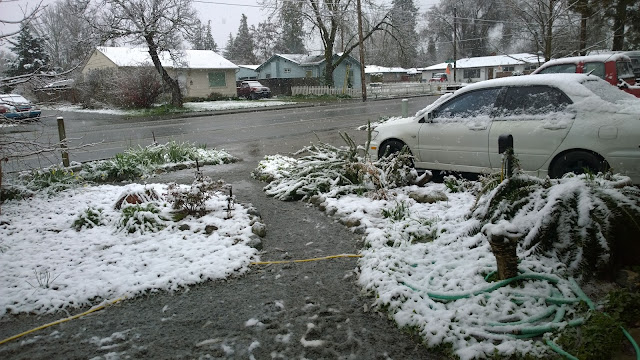The most dangerous weeds are annuals and
biennials that seed and dry out in a season. They make many seeds, some of which can last
for years in soil before they sprout or rot.
But their roots don’t need to be
pulled to kill them. All their top
growth comes from their crowns, the part of the plant between the roots and the
stems. Cut them under their crowns or
pull them when they are flowering before they go to seed and they are
gone, but it can take years to control the seeds already in the ground
You can cut them under their crowns with
scissors or a knife, which is great for going after individual weeds, but
is relatively slow. Still, this is the
best way to handle seeded puncture vine, a noxious weed that pops bike tires as
well as sticking shoes and bare feet. Cutting
under crowns or pulling are the only ways to take weeds out selectively in
lawns, beds and borders.
You can also beat the crowns out of the
soil wholesale with a string trimmer.
This works best when the plants are young and not yet seeded, and the
soil is relatively soft. It has to be
repeated to catch newly sprouted annuals and re-growing perennials. Done often and long enough, it can kill out
perennials as well. It is rather messy. A hula hoe (AKA scuffle hoe and stirrup hoe) doesn’t
throw stuff around.
You can mulch with leaves, compost, wood
chips or bark to smother small plants and stop seeds from sprouting. Most very small seeds need a touch of
sunlight to sprout, and nearly every newly sprouted plant can be easily
smothered with 2 inches or more of dense mulch.
Avoid fine bark and bagged bark with fines; bark’s natural preservatives
leach downward and kill soil life, but not plants. Larger barks do not kill
soil, but ¾” bark and walk-on fir are dense enough at 2” deep. Walk-on fir bark is most effective at staying
put; ¾” floats away on slopes.
Leaves are the most effective mulch, though
some tend to blow around. Leaves that
last for a year, like oak and red maple, are most effective. They
dry quickly on the surface and make a lousy seed bed for whatever falls on
them. Leaves and compost also feed soil
life, which makes the soil soft for pulling weeds and provides habitat for good
(predator) bugs.
Perennial
weeds like blackberries can also be fire hazards and nuisances. Cutting under or pulling their crowns is
effective, but birds drop seeds in their droppings. When it comes to weeding, constant vigilance
and watering is the key.
Revised
12/10/2024. Published at
GardenGrantsPass.blogspot.com
Rycke Brown, Natural Gardener 541-955-9040 rycke@gardener.com









